Food Plot Choices: What To Plant?
Food Plot Choices: What To Plant?
Ultimate Land Listings, LLC
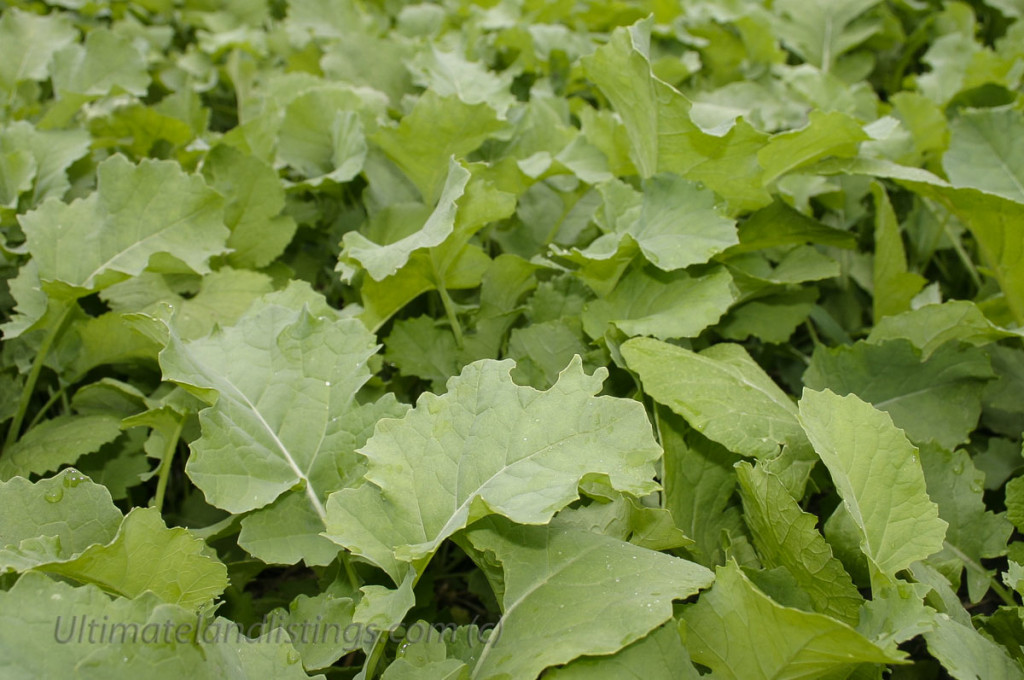
(Brassica mix — photo above. Turnips, Rape and kale. This mix provides a super attractive food plot area for whitetails late fall into winter in the midwest region).
Lots of choices here! Things like alfalfa, brassicas, clover, corn, Milo, rye, soybeans and wheat are all potential food plot choices and are eaten by deer heavily during various times of the year. Any of these could make a good food plot choice in the right place at the right time. Remember deer like different food choices at different times from various types of browse — like wild plum branch tips and osage orange leaves, to honey suckle or coral berry leaves. When it comes to “grazing” choices — and deer are not grazers but are rather browsers — deer will nibble on various grasses to things like rye, clover and turnips, mentioned above. This is just something to keep in mind. The attraction level of your food plot to wildlife will vary according to the growth stage of the plant and the diversity of food choices given deer in the area. No one food plot species is going to be preferred by whitetails or turkeys at all times of the year!
Remember, food supplies in nature dwindle and shift, season-to-season, and deer are used to this and they do the same — even if presented a favorite food choice, deer will often shift day to day from it to something else, because it is so ingrained in them and that is what they are “supposed” to do.
What to plant boils down to the types of soils you have to work with, food plot location (aspect to sun and shade), the amount of money you have to put into the project and the type of equipment available to use. And of course, what time of year you want to draw in the wildlife.
Lets consider type of soil first.
Corn, beans and alfalfa demand good soils with PH levels above 6.3 for the most part (a soil test should be done to determine soil PH and how much lime and fertilizer needs to be added according to what you’d like to plant). The various white clovers like good soil as well and they also like moist conditions and even some shade.
Red clovers can do well in upland areas on less than prime soils. Red clover varieties also tolerate dry conditions much better than the whites do in general.
When it comes to winter wheat, it can be grown on a variety of soils types but does better than does cereal aka “winter rye” rye moist-wet soil. Rye tends to grow better than does wheat on low grade and low PH soils. Choices like rape, turnips and kale are good for a wide variety of soil types. Deer are generally most attracted to kale, rape, turnips, parsnips and other “brassicas” when the weather is cold — fall planted brassica food plots are most preferred for whitetail use.
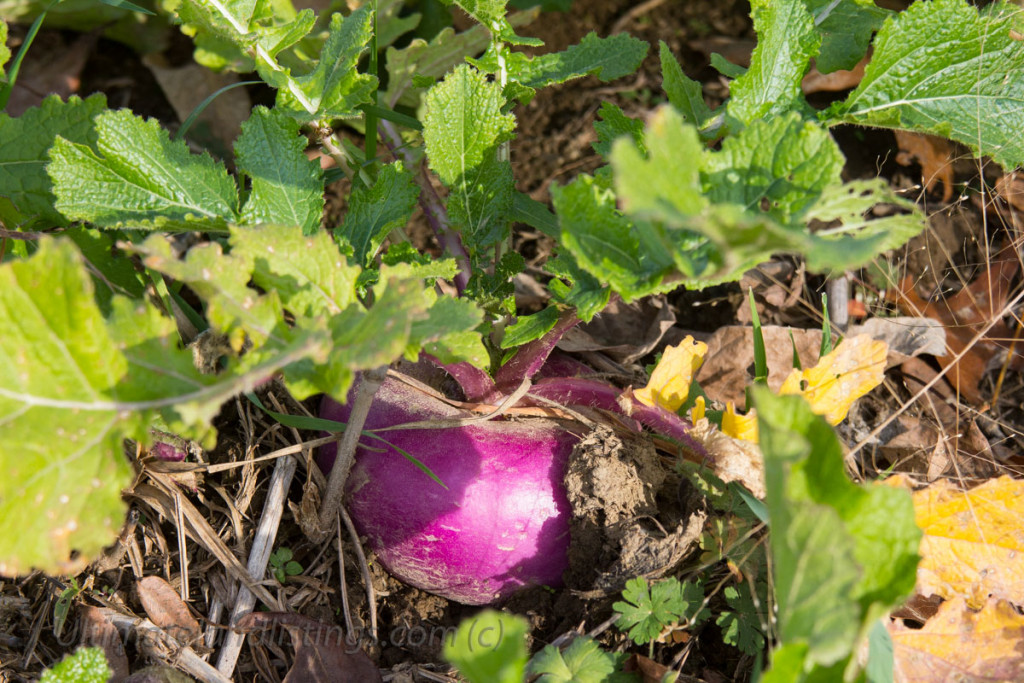
(purple-top turnip, above photo. Deer love these in the fall and winter seasons)
What about deer attraction?
It’s hard to beat corn for deer attraction — same goes for alfalfa really. Deer love alfalfa, especially after a fresh cutting, summer through fall and into winter, if they can get at it through he snow. However, alfalfa is rather expensive and can be tricky to get started and annual fertilizing and liming are sometimes required. Alfalfa also should be cut regularly during the growing season to be kept at optimal growth stages for whitetail attractiveness. However, one can makes some money off of this in the end if he/she opts to sell some of the bales produced by the cuttings. So unless one farms out the alfalfa to someone, I would suggest the individual land steward think carefully before delving into alfalfa. It can be a great choice for the right individual however.
Deer love corn — probably better than anything else I can think of, especially during late fall and winter. The problem is corn needs good soils, adequate fertilizer/lime and needs to be properly planted to yield top results. It also suffers the most of any food plot choice from predation: squirrels, raccoons and even beaver (cutting stalks to build a dam or lodge) can reek as much havoc on a field as can the deer and turkey you are trying to attract. Also, deer are fond of eating the silks and young ears of corn during early summer. This means even a good size corn field can be decimated before hunting season even arrives! But corn can work as a food plot choice. Corn typically works best in areas of moderate deer numbers with other diversionary food choices available. Plots smaller than about 3 acres in high deer density areas having few other crops or high quality food choices available in the area, tend to be wiped clean long before the onset of winter — sometimes by early fall!
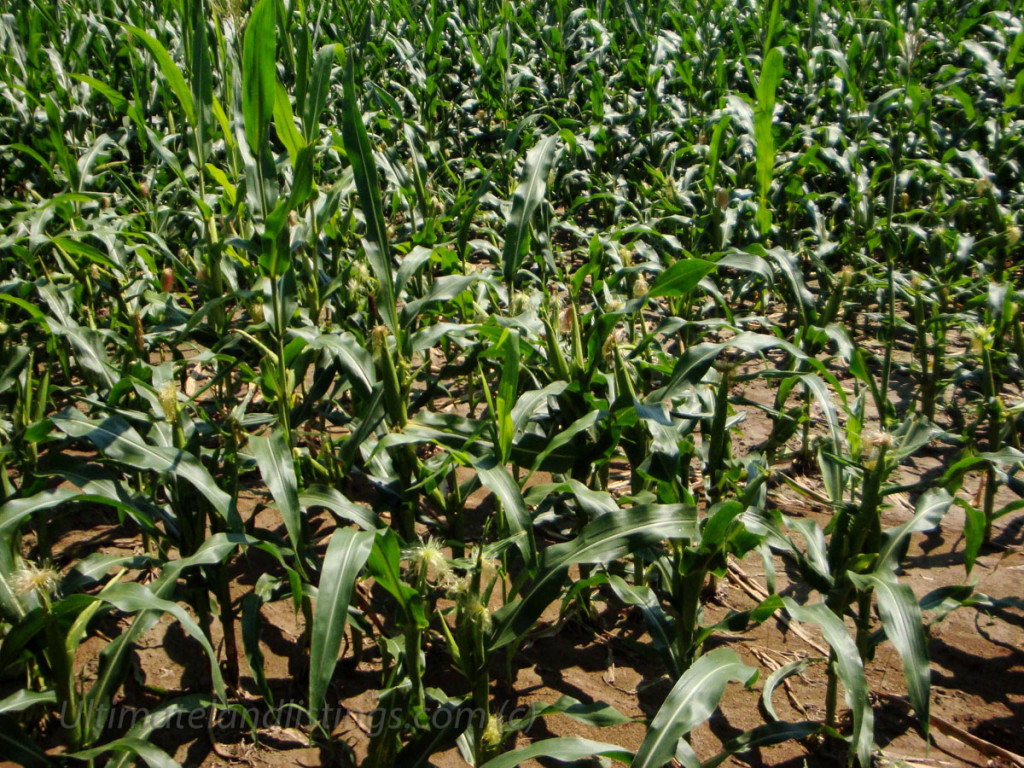
(Corn field above planted for deer. The problem with corn is that deer eat the silks during the development stage of the ear in early summer. And, lots of other animals also love corn. So…when fall arrives there may not be many ears left in the field!)
Soybeans are a solid food plot choice. They are attractive to whitetails during the summer (the foliage) and again late in the year after other choice items such as acorns, corn, alfalfa, etc., are gone or are hard for wildlife to access because of snow. Soybeans are also relatively easy to plant and do not get predated upon nearly as hard as corn. Beans do demand good soils, though, with PH values in the neighborhood of 6.3 or above. And, the seed is moderately expensive to plant. Another good aspect of soybeans if you are hunting near a plot is that you can see the deer in the field. Something that is tough to do when hunting a tall corn field!
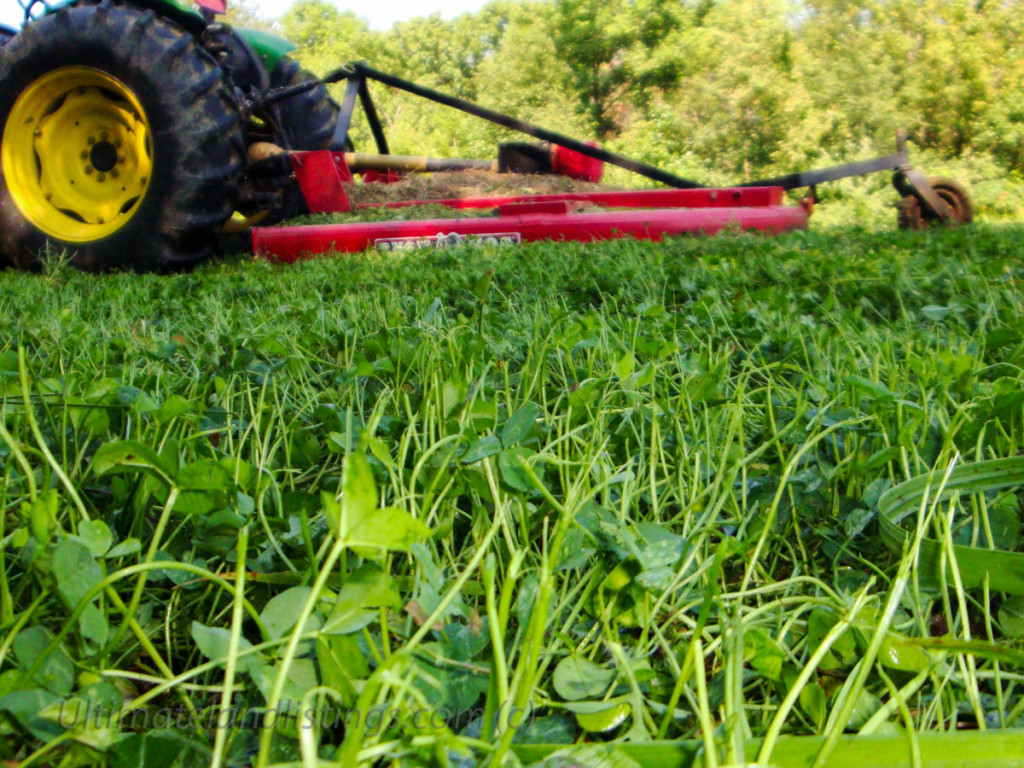
(Above photo showing clover plot being mowed)
Undoubtedly, any of the various clovers are the food plot choices of many. And for good reason. According to species, clovers can be planted in a wide variety of soil types, are relatively cheap and easy to plant, are easy to maintain and attract both deer and turkey over a long seasonal time span (early spring through late fall when plants get set-back by frost).
A very good annual food plot choice for fall attraction is either winter rye or winter wheat. Both are cheap to plant and easy to grow. Deer like both, especially if other quality foods in the area are limited. As mentioned earlier, rye outgrows wheat on poorer and/or dryer soils. Wheat requires a bit better soil and likes more moisture. Both of these should be planted in late August through mid-September for optimal deer forage in Iowa.
Other less widely utilized food plot choices include the brassica’s as we’ve already mentioned some (rape, turnips, kale, etc.), Egyptian wheat, millet, sunflower and grain sorghum. Egyptian wheat makes an interesting choice in that it grows to 10 feet tall! For this reason, strips can be planted along property boundaries to keep intruding eyes off of larger food plot areas within the property. Egyptian wheat produces large seed heads and the deer tend to push the seed heads over breaking the plant in the middle. E. Wheat makes a great food plot and deer attraction choice in areas where deer have few choice food items present fall-winter. And because of it’s size, deer often bed down and live right amidst the field. So it is an excellent choice for producing both food and cover! We often plant big blocks of E. wheat to serves as deer sanctuary cover during the gun season. If you plant the wheat lightly, grass grows between the stalks — it looks like a poor “farm field” but the deer get in there and love using it for sanctuary with those grasses in there serving well for attractive bedding cover. We also bush-hog strips through E. wheat and use them for silent trails through the tall cover to secretively access our stand sites in certain areas.
The brassica’s are becoming more widely planted by deer enthusiasts every year. And with good reason. They grow in a wide variety of soil types, are easy to grow. Brassica’s are also inexpensive to plant. It may take deer up to a year to figure out what to do with these new types of forage plants, but once they do — look out! Whitetail like them! The brassica’s are most heavily browsed late in the fall and on throughout the winter.
Should I plant one species or a mix, you ask?
Since no one particular type of plant is best suited for the vast array of weather variables and since no one species is always favored by deer/turkey throughout the season, a good strategy is to plant a combination of plants — this works very well with the small seeded food plot species, such as the clovers and brassica’s.
We often plant either rye or wheat (or combination thereof) in fall. Then, come in and seed in a combo of clover varieties (sometimes mixed with brassica) in the early spring. The rye/wheat acts as a nurse crop, protecting the establishing clover seedlings from harsh weather conditions until they get firmly established by early June. We then go in and mow the mature wheat/rye in early July, leaving a lush field of protected clover underneath. The brassicas will last one year while the clover will last 3-5. This is a very good way to establish a clover food plot.
Depending upon location — wet soils/dry soils, shade/sun, etc…. — I like to mix a combo of white and red clover species when I seed. Thus, regardless of weather conditions, the food plot has species that should do well. Whereas a mix of solid ladino clover (white) for instance, could yield poor results should a dry summer occur. During a wet year, a field of red could produce less than ideal results. Deer like both but do show a preference toward the white clovers. For this reason, I try to plant a higher percentage of white than red clover whenever the field conditions warrant. I have had really good luck with the white clover varieties of Dutch white and Large or Jumbo leaf ladino in southern Iowa where I most often plant food plots. Medium red clover is the red variety I usually plant.
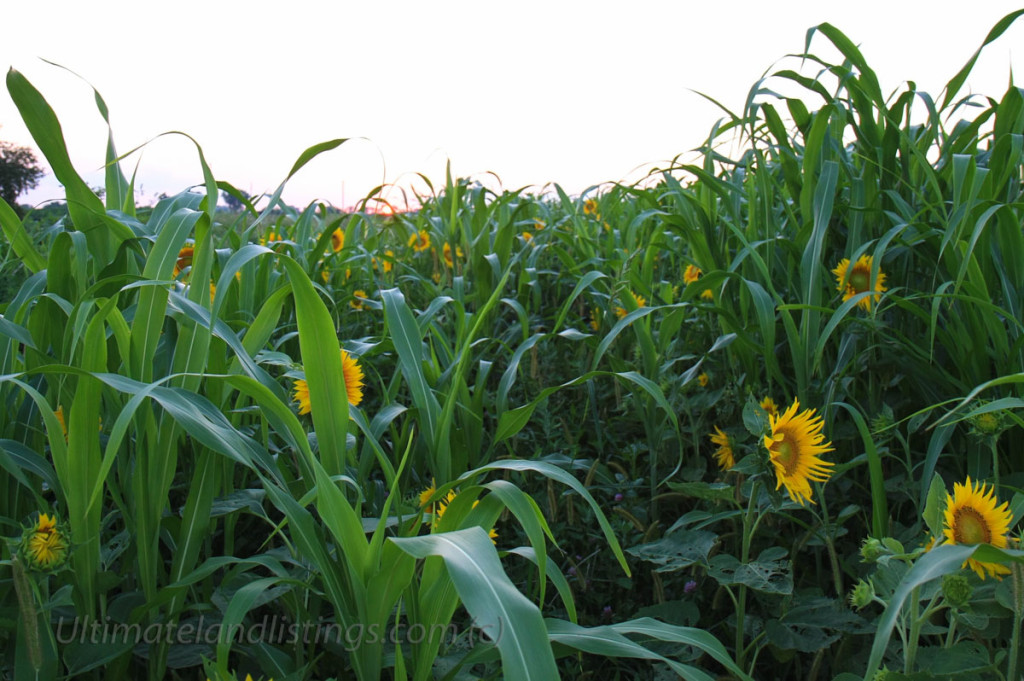
(The above photo depicts a mix of soybeans, Egyptian wheat, and sunflowers — this is a superb mix for whitetails and other wildlife and provides both food and cover for much of the year)
Another interseeding option is a field of soybeans with winter rye during fall. This makes effective utilization of nearly every square inch of top soil in your plot. One can even do this in a corn field or within Egyptian wheat. Whenever you plan to spread rye on top of the ground, however, be sure to do it before a predicted heavy rain/wheat weather period. Rye will germinate and establish this way but only over an extended period of rain and cool weather. Should you get such conditions it can work well. Rye works better than wheat for doing this because it needs less moisture to germinate.
I hope this information helps some — good hunting to you!

